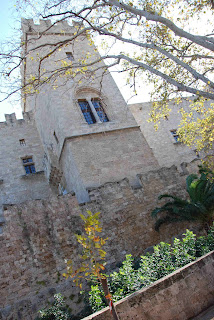Route of the Ancient Traders
Day 3
M/S Nautica
Rhodes, Greece
Clear – 67 Degrees
The ship docked at the old port of Mandraki in Rhodes Town just outside the city walls. The harbor is believed to be the site of the Colossus of Rhodes, one of the Seven Wonders of the Ancient World. This statue, over 30 meters tall, was dedicated to the Greek God Helios. It was erected between 292 B.C. and 280 B.C., but fell in an earthquake just 56 years later. The bronze was recycled and the Colossus was lost forever.
They say Rhodes is at the crossroads of three continents: part of Europe, just off the coast of Turkey in Asia, and on the route to Africa.
We drove SouthWest out of the harbor, along the very well preserved city wall and out of town. Rhodes is a major resort destination for Central and Eastern Europe. The West coast is full of hotels, now closed or closing for the season. The rocky sandy beaches were mostly deserted on this perfect fall day, but there were a few fisherman and even a few swimmers in Speedos in and out of the water. The coastline is incredibly beautiful. The surf was translucent aquamarine and the sea beyond a deep sapphire.
Our first stop was Mount Smith. This is one of the highest points on the island and has been held sacred by each of its conquering civilizations. There are the ruins of the ancient Greek Acropolis of Ialyssos, a church built by the Knights of St. John and restored by the Italians, and amazing views of Rhodes, the Aegean Sea, and Turkey in the distance.
As we arrived at the top of the mountain, we were greeted by a flock of wild peacocks. The site is bisected by a stone path. At one end is the church and a viewpoint looking West. At the other end is a giant Cross and a viewpoint looking East. The Cross towers above the island like Christ the Redeemer in Rio de Janeiro, on a smaller scale. The Cross we see today is not the original. The Italians held the island in the early part of WWII and built a military airport nearby. They were afraid that Allied bombers would use the Cross as a guide to target the airport so they destroyed it. It was rebuilt by the Greek government in the 1990s.



We made our way back to Rhodes for a walking tour of the Old Town, beginning at the restored 14th-Century Grand Masters Palace. The palace was built by the Knights of St. John, but it was mostly destroyed by an explosion in the 1850s. The old cathedral next door was used during the era of Turkish control as a munitions warehouse. It was fully stocked with gunpowder when it was struck by lightning. The palace was rebuilt by the Italians in the 1930s, but the restoration was not faithful and it is now just a museum housing a hodgepodge of antiquity. Historically, the palace served as a fortress in times of war, the residence of the Grand Master and a meeting place for the Knights of St. John.

 We continued down the Avenue of the Knights, a cobblestone street with high marble sidewalks on either side. It was home to visiting knights with inns designated for knights from each region. The streets of Old Town are devoted to tourism now.
We continued down the Avenue of the Knights, a cobblestone street with high marble sidewalks on either side. It was home to visiting knights with inns designated for knights from each region. The streets of Old Town are devoted to tourism now.Tres stopped at a stand to get a gyros. Not beef and lamb as we are used to, but pork and chicken. Maybe that is traditional in Rhodes, but the French fries stuffed inside??? That must be just for Americans.
We finished our walk and boarded the ship.
Next stop: Limassol, Cyprus
Next stop: Limassol, Cyprus


No comments:
Post a Comment